When starting a hiking journey in the Lake District, guarantee your safety by planning your route with reliable maps and notify someone of your plans. Check mountain-specific weather forecasts regularly and dress in layers, including a waterproof jacket. Equip yourself with proper hiking gear, such as sturdy boots and a first aid kit. Always carry a charged phone and be familiar with local emergency procedures. Be mindful of changing terrain and potential hazards like slippery trails and wildlife. Finally, familiarize yourself with local resources and guided walks for further insights and preparation tools for an enriching experience.
Key Takeaways
- Choose trails that match your skill level and use maps or hiking apps for navigation.
- Regularly check mountain-specific weather forecasts and prepare for rapid weather changes.
- Wear sturdy walking boots with ankle support and pack layers for varying temperatures.
- Inform someone of your hiking route and estimated return time for safety.
- Carry a first aid kit, a charged phone, and know emergency procedures, like contacting Mountain Rescue.
Planning Your Hiking Route
When starting on a hiking adventure in the Lake District, effective planning of your hiking route is paramount to guaranteeing both safety and enjoyment. Trail selection should align with your skill level and interests, offering a balance between challenge and accessibility. Utilize resources such as maps, hiking apps, and local guidebooks to identify trails that complement your abilities.
For beginners, opting for lower-level walks can provide spectacular views while minimizing risks, making these routes ideal for those new to hiking.
Route mapping is an essential step in your preparation. Thoroughly understanding your selected path, including its elevation and difficulty, is vital to avoid unexpected challenges. Particularly for higher elevation walks, this understanding helps plan your return before nightfall, guaranteeing a safe and timely conclusion to your hike.
Informing someone about your planned route and estimated completion time is a prudent safety measure, as it guarantees assistance can be summoned in case of emergencies.
Consider joining guided walks led by expert volunteers. These not only simplify navigation but also enrich your experience with local insights, allowing you to appreciate the Lake District's natural beauty more deeply.
With careful planning, your hiking adventure can be both rewarding and safe.
Understanding Weather Conditions
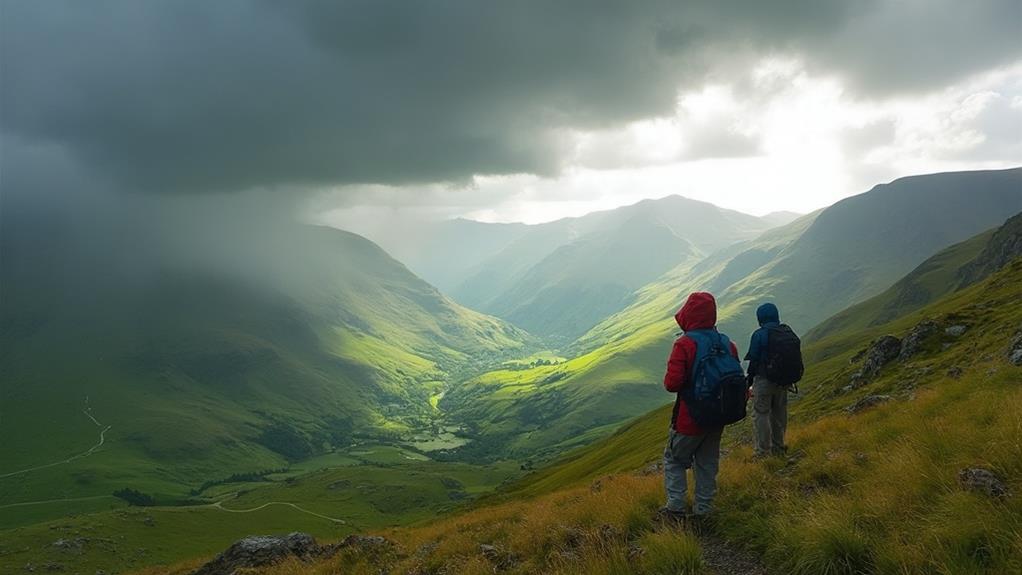
When preparing for a hike in areas like the Lake District, it is essential to regularly check mountain-specific weather forecasts, as conditions can change rapidly.
Equip yourself with tools such as weather apps and webcams to receive real-time updates and visual insights into current conditions.
Check Forecast Regularly
Understanding the intricacies of weather forecasting is vital for guaranteeing a safe and enjoyable hiking experience. For beginners in the Lake District, regular checks using reliable weather apps are essential. These tools offer forecast accuracy that helps anticipate weather changes. Always consult mountain-specific forecasts at least a day in advance and on the morning of your hike to stay informed.
The weather in the Lake District is notoriously unpredictable. To help plan effectively, here's a table summarizing key resources:
| Resource | Purpose | Access Method |
|---|---|---|
| Met Office | Accurate mountain weather forecasts | Website, App |
| Local Outdoor Shops | Updated weather insights and advice | In-person, Phone |
| Webcams | Real-time views of hiking conditions | Online Platforms |
Utilizing these resources guarantees you're prepared for sudden shifts in conditions. Webcams positioned around popular areas like Helvellyn provide a real-time snapshot of the environment, aiding in decision-making. Prioritizing safety, be ready to alter or postpone plans if severe weather is forecasted, especially in exposed locations. Embrace the unpredictability of mountain weather by staying informed and prepared, turning potential challenges into an enriching hiking experience.
Prepare for Changes
As the weather in the Lake District is famously capricious, hikers must prepare for sudden changes by thoroughly understanding weather conditions. Equipped with the knowledge that conditions can evolve rapidly, particularly at higher elevations, hikers can better safeguard their experiences.
An essential step is consulting mountain-specific weather forecasts, which provide tailored insights that general forecasts might overlook. Reliable sources like the Met Office or local outdoor shops offer precise updates vital for planning.
Weather adaptability is key, and clothing versatility plays a significant role in achieving this. Packing should include layers such as thermals and waterproofs, allowing hikers to adjust to fluctuating temperatures and sudden downpours. This preparedness not only enhances comfort but also guarantees safety amid the Lake District's unpredictable skies.
Additionally, hikers should remain vigilant regarding rainfall predictions, as high rainfall can transform trails into slippery hazards and render rivers impassable. Being informed allows for informed decision-making, enhancing the hiking experience.
Embracing flexibility in plans is equally important; adapting routes or seeking alternative activities can avert potential risks. By prioritizing these strategies, hikers can fully enjoy the natural beauty of the Lake District while maintaining a proactive approach to safety.
Avoid Severe Weather
While starting a hiking adventure in the Lake District, it is vital to prioritize avoiding severe weather by thoroughly understanding weather conditions. The region's weather can change unexpectedly, making it important to check mountain-specific weather forecasts before setting out. By doing so, you can make informed decisions and take necessary storm precautions to guarantee a safe hiking experience.
One practical step is to utilize reliable weather services such as the Met Office, as well as local outdoor shops, which provide up-to-date forecasts and conditions tailored to the unique microclimates of the Lake District. Monitoring weather apps and local webcams can also offer real-time updates on approaching weather systems, helping you adjust your plans accordingly.
Be particularly cautious of steep and exposed areas during storms or high wind forecasts, as these conditions can greatly increase the risk of injury. Additionally, high rainfall can render rivers impassable and create slippery conditions on rocky terrain, making accidents more likely.
As a result, it is advisable to have a flexible itinerary and be prepared to alter your route or even postpone your hike if severe weather is predicted. By staying informed and prepared, you can enjoy the beauty of the Lake District safely.
Recognizing Key Hazards
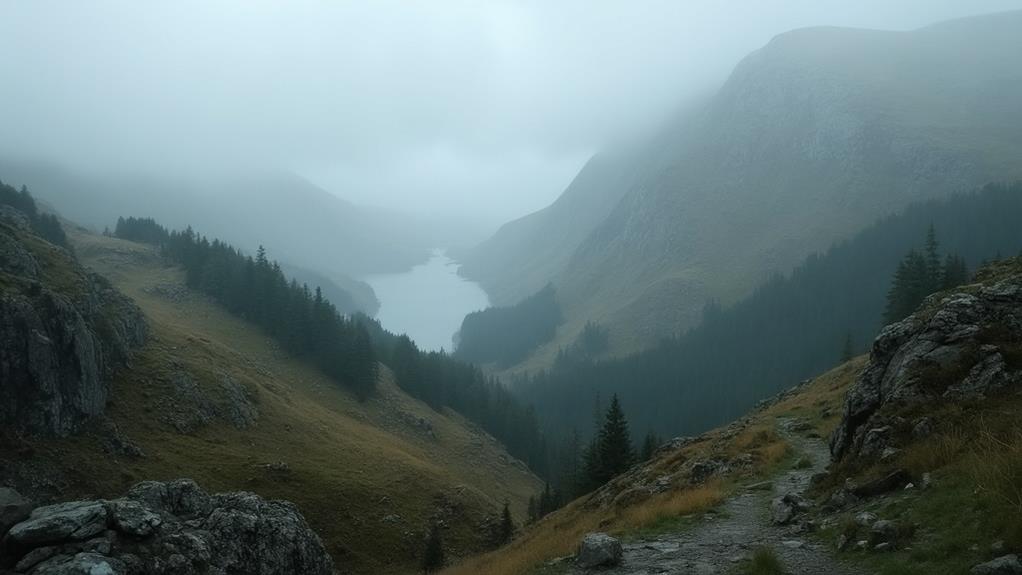
When starting on a hike in areas like the Lake District, recognizing key hazards is essential to guarantee a safe and enjoyable experience.
Beginners should be prepared to navigate challenging terrains such as steep ridges and rugged pathways, while also being aware of water hazards like cold tarns and untreated natural water sources.
Additionally, understanding how to safely interact with wildlife and adhere to the Countryside Code when encountering livestock can prevent unwanted incidents and protect both hikers and animals.
Navigating Rugged Terrain
Hiking in the Lake District presents a unique challenge due to its steep ridges and rugged mountain pathways, which demand meticulous attention to avoid slips and falls. Successful navigation of this challenging terrain requires a combination of effective trail techniques and heightened terrain awareness.
As you traverse these paths, it is vital to remain vigilant, continually evaluating the ground conditions and adjusting your stride accordingly. This proactive approach helps in identifying loose stones or slippery patches that could lead to accidents.
Proper footwear, designed to provide grip and stability, is essential for maintaining balance on uneven surfaces. Equally important is the use of hiking poles, which can offer additional support and help distribute weight more evenly.
Furthermore, familiarizing oneself with topographical maps and using GPS devices can enhance your ability to predict and prepare for changes in elevation or unexpected obstacles.
While focusing on the path ahead, be mindful of environmental factors, such as the presence of livestock or ticks in grassy and wooded areas. Following the Countryside Code guarantees respectful and safe interactions with animals.
Avoiding Water Hazards
Steering through the rugged terrain of the Lake District is only part of the hiking experience; understanding and avoiding water hazards is equally important. Ensuring water source safety is vital, as natural water sources may be contaminated. Hikers should carry sufficient bottled water to stay hydrated and avoid the health risks associated with drinking untreated water from streams or tarns.
Moreover, while the appeal of wild swimming in the Lake District's picturesque tarns and rivers is undeniable, it requires caution. Water temperatures can be surprisingly cold, even during summer, posing a serious risk of hypothermia. Adhering to swimming precautions, such as evaluating water depths and temperatures before entering, is essential for safety.
In addition to these concerns, the region's high rainfall can greatly alter the landscape. Rivers can become impassable, and wet conditions may render rocky paths dangerously slippery. Exercising prudence and avoiding river crossings during heavy rains can prevent accidents.
Lastly, familiarizing oneself with resources like the Countryside Code can offer further guidance on traversing natural hazards safely. By being proactive and cautious, hikers can enjoy the Lake District's beauty while minimizing the risks associated with water hazards.
Wildlife and Livestock Safety
Maneuvering the verdant landscapes of the Lake District involves not only appreciating its stunning scenery but also recognizing and mitigating potential hazards posed by wildlife and livestock. Understanding livestock behavior is vital; sheep and cattle may react unpredictably.
Adhering to the Countryside Code is essential: maintaining a safe distance and keeping dogs on leads near livestock can prevent stress or injury to the animals and yourself.
Ticks, prevalent in grassy and wooded areas, pose a risk of Lyme disease, emphasizing the importance of tick prevention. Wear long sleeves and trousers to minimize exposure, and perform thorough checks on yourself and companions after traversing through vegetation.
This simple practice can notably reduce the likelihood of tick bites and subsequent health concerns.
The Lake District's diverse wildlife, such as deer and nesting birds, deserves respect and space. Observing from a distance is particularly important during breeding seasons to avoid disrupting their natural behavior.
Staying on marked paths minimizes the risk of disturbing wildlife and encountering unstable terrain.
Key Points for Safety:
- Understand livestock behavior to maintain safe distances.
- Prioritize tick prevention with appropriate clothing and checks.
- Respect wildlife by observing from a distance and sticking to paths.
Preparing for Emergencies
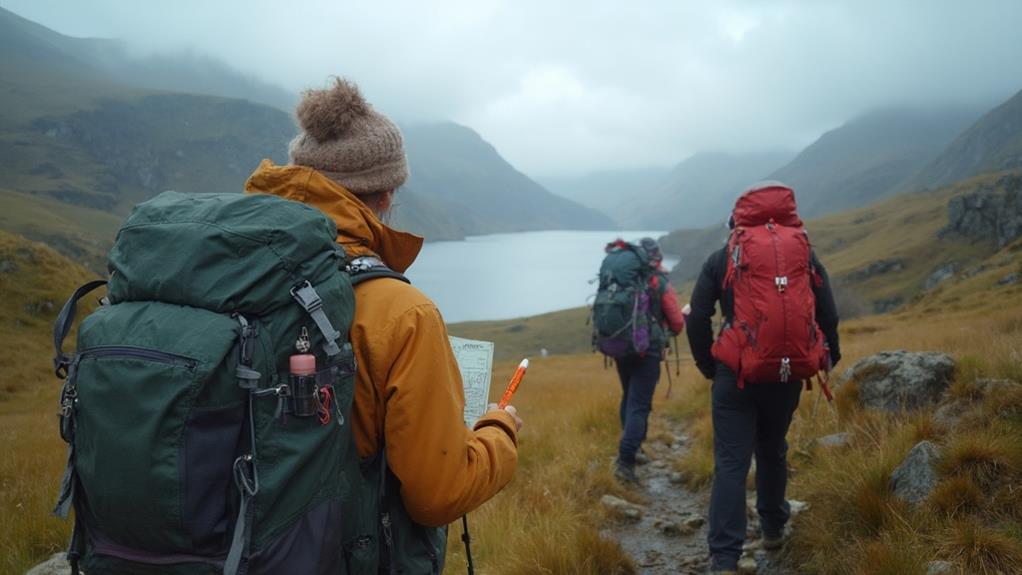
When starting on a hiking adventure, especially as a beginner, it is essential to be well-prepared for any emergencies that may arise. One of the key steps is to establish emergency contacts who are aware of your hiking route and expected return time. This guarantees that someone can alert authorities if you do not return as planned.
Additionally, carrying a charged mobile phone is critical, as it can be used to reach emergency services. In areas with weak signals, texting can be an effective way to communicate your situation.
Familiarizing yourself with emergency procedures is fundamental. Knowing how to contact Mountain Rescue by dialing 999 or 112 and providing detailed location information can greatly expedite assistance.
Equally important is carrying a basic first aid kit. Understanding how to use items such as bandages and antiseptic wipes can make a considerable difference in managing minor injuries on the trail.
Moreover, considering additional safety measures like a survival bag or group shelter can provide necessary protection during unforeseen circumstances or adverse weather conditions.
Essential Hiking Gear
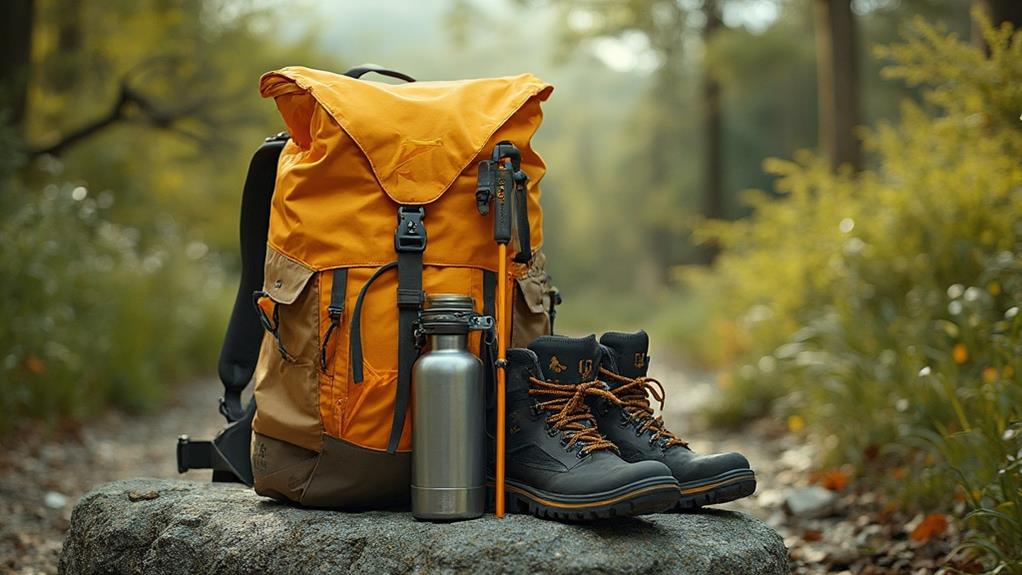
Starting on a hiking adventure requires careful consideration of essential gear to secure both safety and comfort throughout your journey. The Lake District's unpredictable weather and challenging terrain necessitate a well-prepared packing checklist. Prioritize your hiking gear essentials to guarantee a smooth and enjoyable experience.
First, invest in a comfortable day sack or rucksack that fits well. Choose the size based on the hike's length, ensuring you can easily carry all necessary items. Properly adjusted straps will distribute weight evenly, helping you maintain balance and endurance.
Second, select appropriate footwear. Sturdy walking boots with good ankle support and tread are essential for traversing the rugged paths. These will minimize the risk of injury and provide the comfort needed for longer treks.
Lastly, always pack a waterproof jacket and over-trousers. The weather in the Lake District can change suddenly, and staying dry is critical to maintaining body temperature and morale.
In addition to these key items, remember to include a first aid kit, a map and compass for reliable direction, and ample water and high-energy snacks to sustain your energy levels.
Preparation is fundamental, and your hiking gear essentials will make all the difference.
Suitable Clothing Choices
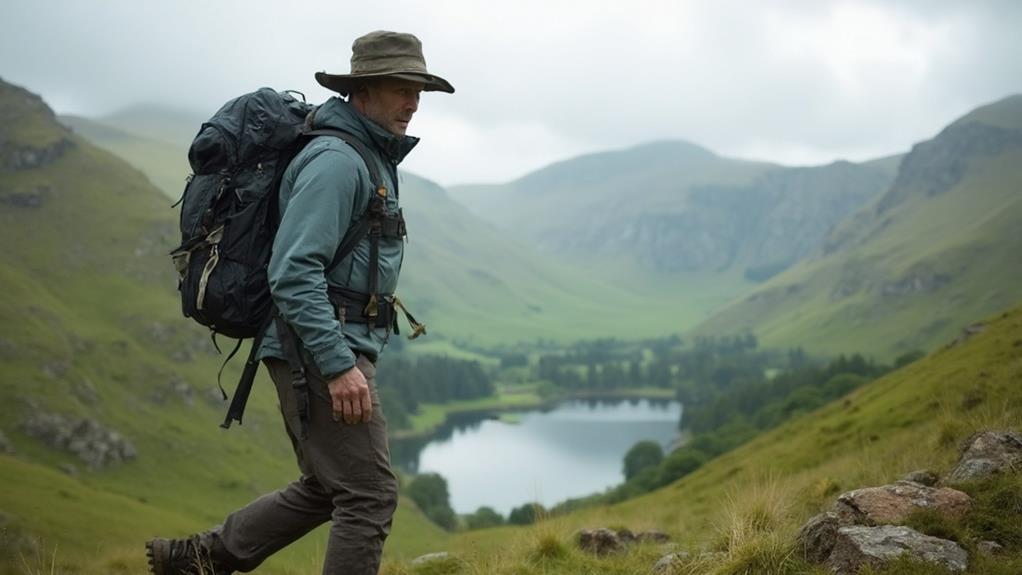
When starting a hike in the Lake District, choosing appropriate clothing is vital for comfort and safety.
Emphasizing weather-appropriate layering, such as waterproof jackets and breathable insulating layers, can greatly enhance your hiking experience by keeping you dry and maintaining ideal body temperature.
Equally important is selecting proper footwear; sturdy walking boots with ankle support and good tread are essential for traversing the region's challenging terrain safely.
Weather-Appropriate Layering
Proper attire is a cornerstone of a safe and enjoyable hiking experience, particularly in the unpredictable climate of the Lake District. The art of layering is essential for maintaining comfort and safety. By wearing multiple layers, you can easily adjust to fluctuating temperatures and sudden weather changes.
Begin with a moisture-wicking base layer to aid temperature regulation. This is followed by insulating layers to retain warmth. Finally, a waterproof outer layer acts as a critical emergency layer, protecting against rain and wind.
Consider these practical clothing choices to enhance your hiking experience:
- Waterproof Jacket and Over-Trousers: Essential for guarding against sudden rain showers and wind gusts, keeping you dry and comfortable.
- Insulating and Breathable Fabrics: Opt for materials that allow sweat to escape while keeping you warm, important for temperature regulation, particularly during breaks.
- Quick-Drying Trousers: Choose comfortable trousers made from quick-drying materials rather than cotton or denim, which can become cumbersome when wet.
Don't forget accessories like a hat and gloves, as temperatures can drop considerably at higher elevations.
Essential Footwear Selection
Choosing the right footwear is as important as selecting the appropriate clothing for a successful hiking adventure in the Lake District. The region's rugged and often slippery terrains demand walking boots that provide both ankle support and a good tread. This combination guarantees stability and traction, essential for traversing the uneven paths and inclines found throughout the area.
When considering footwear materials, aim for durability and water resistance to withstand the unpredictable weather conditions, including sudden downpours and muddy trails. High-quality leather or synthetic boots are ideal, offering a balance of robustness and breathability.
In addition to sturdy footwear, appropriate clothing choices enhance the hiking experience. Opt for quick-drying fabrics for trousers, steering clear of cotton and denim, which retain moisture and can become uncomfortable.
Layering clothing with insulating and breathable materials is vital to regulate body temperature during breaks and adapt to the Lake District's rapidly changing weather conditions. A lightweight, effective waterproof jacket and over-trousers are important for remaining dry during unexpected rain.
Group Safety Dynamics

Understanding the intricacies of group safety dynamics is crucial for beginners starting on hiking adventures. The safety and enjoyment of a hiking group are heavily influenced by the fitness and skill level of its members, particularly the least experienced. A thorough fitness assessment should be conducted, allowing for the selection of a route that suits the capabilities of all participants.
Open group communication is essential; discussing comfort levels and limitations guarantees that decisions made benefit everyone and maintain group cohesion.
To enhance safety and build confidence, groups can adopt a gradual approach to fitness building. Starting with easier trails and progressively tackling more challenging hikes allows everyone to develop their abilities and stamina.
Here are three practical tips for maintaining group safety dynamics:
- Encourage Open Dialogue: Regularly check in with group members about their physical condition and any concerns they might have.
- Assess Fitness Levels: Choose trails based on the capabilities of the least experienced hiker to prevent overexertion.
- Recognize Limits: Be vigilant about signs of fatigue. Agree as a group to take breaks or turn back if needed to guarantee safety.
Navigating With Confidence

While group safety dynamics play an essential role in guaranteeing a successful hiking experience, maneuvering with confidence is equally important for every hiker. A fundamental aspect of this is mastering map reading and compass skills, indispensable tools for traversing the often unpredictable terrain of the Lake District.
In remote areas where GPS devices may fail, a detailed paper map and a reliable compass become indispensable allies. Familiarize yourself with the local rights of way, marked by yellow arrows for public footpaths and blue arrows for bridleways, to secure safe and legal navigation.
Before starting your journey, it's prudent to check mountain-specific weather forecasts to anticipate potential conditions that may influence your route. Planning your hike with this information helps to mitigate risks and prepares you for unexpected changes.
Additionally, always inform someone of your intended route and expected return time, creating a safety net in case of emergencies.
To cultivate confidence in your navigational abilities, practice on lower-level paths before advancing to more challenging hikes. This gradual approach allows you to build experience and assurance in using your map and compass effectively, laying a solid foundation for more ambitious adventures.
Staying Aware of Wildlife

Encountering wildlife in the Lake District is an enriching experience that adds a vibrant dimension to any hiking adventure. The region's diverse fauna, from majestic red deer to elusive otters, requires a thoughtful approach to guarantee both personal safety and the well-being of these creatures.
Understanding wildlife behavior is important; animals such as peregrine falcons and other rare bird species are sensitive, especially during breeding seasons, so maintaining a respectful distance is essential. Binoculars can enhance your experience without causing disruption.
Conservation awareness is paramount. Adhering to the Countryside Code helps protect the delicate balance of this ecosystem. For instance, livestock like sheep and cattle may seem approachable, but they can become agitated if disturbed. It's crucial to admire them from afar and stay on designated paths.
Additionally, be vigilant about ticks, which thrive in areas with long grass and dense vegetation. Regular checks on yourself and pets after hikes can prevent Lyme disease.
To guarantee a positive experience:
- Use binoculars to observe wildlife from a safe distance.
- Adhere to the Countryside Code to avoid disturbing livestock.
- Check for ticks after hiking to prevent health issues.
Embrace the beauty of the Lake District responsibly.
Exploring Local Attractions

Exploration is the key to uncovering the hidden gems of the Lake District, a region rich in both natural and cultural allure. This area invites beginners to investigate its myriad attractions, each offering unique experiences.
For instance, Wild Cat Island, accessible by boat trips, provides scenic hiking trails perfect for wildlife observation and fishing, encouraging an intimate connection with local culture. Such locations are ideal for capturing scenic photography, with the island's landscape offering a picturesque backdrop.
Friars Crag on Derwentwater is another must-visit, renowned for its breathtaking views and easily accessible via footpaths from Keswick. This site not only serves as an excellent location for photography but also offers an inviting spot for picnicking, allowing visitors to absorb the tranquility of the surroundings.
The region boasts over 100 notable waterfalls, with Aira Force and Stock Ghyll Force standing out for their dramatic displays, especially after heavy rainfall.
These sites not only offer stunning visual experiences but also connect hikers to the folklore and legends embedded in local culture. Many trails are equipped with cafes and picnic areas, providing opportunities to relax and enjoy the natural beauty surrounding them.
Utilizing Helpful Resources

Maneuvering the expansive beauty of the Lake District can be made considerably easier by leveraging a variety of helpful resources.
Trail resources and hiking apps are indispensable tools for beginners aiming to explore this stunning region safely. The Lake District National Park Authority's official website is a treasure trove of information, offering detailed insights on trails, safety tips, and local regulations. This guarantees hikers are well-prepared before starting on their adventures.
To plan effectively, real-time weather updates are essential. Weatherline provides specific mountain forecasts, enabling hikers to adjust their plans according to current conditions. Additionally, mapping apps and guidebooks tailored to the Lake District can greatly enhance route planning and navigation, guaranteeing hikers stay on the right path.
For those who prefer expert guidance, joining guided walks organized by local volunteer groups can alleviate the stress of navigation. These groups offer not only safety advice but also enrich the hiking experience with local knowledge.
Here are three practical tips:
- Consult trail resources on the National Park's website for thorough trail information.
- Use hiking apps for real-time navigation assistance.
- Join guided walks for safety and expert advice.
Frequently Asked Questions
What Is the Easiest Mountain to Climb in the Lake District for Beginners?
Orrest Head is a highly recommended option for best beginner hikes in the Lake District. It features a scenic 2.5-mile circular route, manageable elevation gain, and offers rewarding scenic viewpoints over Windermere, making it ideal for novice hikers.
How Do I Prepare for Lake District?
To prepare for the Lake District, review trail maps meticulously and pack essential gear, including a waterproof jacket and sturdy boots. Familiarize yourself with the route, check weather conditions, and inform someone of your itinerary for safety.
How to Keep Safe if You Go Hiking?
To guarantee safety while hiking, prioritize hiking essentials, including a map and compass for effective navigation skills. Regularly monitor weather forecasts and carry necessary gear like a first aid kit, food, water, and appropriate clothing for varying conditions.
Which Fell Is Easiest to Walk in Cumbria?
Orrest Head is considered one of Cumbria's easiest fells, appealing to novices with its favourite trails. Its gentle 2.5-mile ascent allows hikers to appreciate local wildlife while enjoying stunning views of lakes and mountains.
Conclusion
Hiking in the Lake District requires thorough preparation and awareness. By carefully planning routes, understanding weather conditions, and recognizing potential hazards, hikers can enhance their safety. Equipping oneself with essential gear, maintaining navigation skills, and preparing for emergencies are vital steps. Awareness of local wildlife and exploring nearby attractions enriches the experience. Utilizing available resources guarantees a safe and enjoyable journey. Adhering to these guidelines fosters a rewarding and secure hiking adventure in this picturesque region.